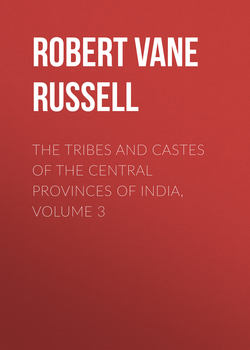Читать книгу The Tribes and Castes of the Central Provinces of India, Volume 3 - Robert Vane Russell - Страница 73
Gond
(f) Religion
55. The Meghnāth swinging rite
ОглавлениеIn the western Districts on one of the five days following the Holi the swinging rite is performed. For this they bring a straight teak or sāj tree from the forest, as long as can be obtained, and cut from a place where two trees are growing together. The Bhumka or village priest is shown in a dream where to cut the tree. It is set up in a hole seven feet deep, a quantity of salt being placed beneath it. The hole is coloured with geru or red ochre, and offerings of goats, sheep and chickens are made to it by people who have vowed them in sickness. A cross-bar is fixed on to the top of the pole in a socket and the Bhumka is tied to one end of the cross-bar. A rope is attached to the other end and the people take hold of this and drag the Bhumka round in the air five times. When this has been done the village proprietor gives him a present of a cocoanut, and head- and body-clothes. If the pole falls down it is considered that some great misfortune, such as an epidemic, will ensue. The pole and ritual are now called Meghnāth. Meghnāth is held to have been the son of Rāwan, the demon king of Ceylon, from whom the Gonds are supposed by the Hindus to be descended, as they are called Rāwanvansi, or of the race of Rāwan. After this they set up another pole, which is known as Jheri, and make it slippery with oil, butter and other things. A little bag containing Rs. 1–4 and also a seer (2 lbs.) of ghī or butter are tied to the top, and the men try to climb the pole and get these as a prize. The women assemble and beat the men with sticks as they are climbing to prevent them from doing so. If no man succeeds in climbing the pole and getting the reward, it is given to the women. This seems to be a parody of the first or Meghnāth rite, and both probably have some connection with the growth of the crops.
